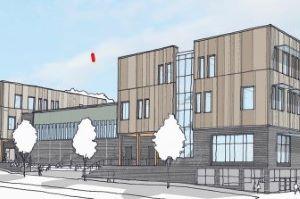-

Building Design for the New Alliance High SchoolCourses Digital Media Design I, US History
Content Area(s) Digital Media Design I, US History
Grades 9,10,11,12Instructor(s)
Amy Taramasso, Catherine VolponiSchool
Alliance HS @ Meek CampusDescription
This project engaged students in creating and presenting their architectural designs for a new building that will house their high school and other Multiple Pathways to Graduation programs in fall 2024. The course was delivered via remote instruction during the pandemic-impacted 2020-21 school year. Coursework included lessons about the historical displacement and exclusion of indigenous and black people in Oregon and how present-day policies and practices guiding development of the built environment tend to exacerbate inequality and perpetuate the erasure and oppression of marginalized groups. Students learned to analyze architecture and design from multiple perspectives and frameworks, including accessibility, trauma-informed design, the BlackSpace Manifesto, and environmental sustainability. Teachers also modeled alternative approaches to organizing virtual space by opening each class meeting with a circle for holistic check-ins with students and by honoring First Peoples with a land acknowledgment. Community partners Your Street Your Voice and the architects designing the new school building were co-instructors and "clients" as students took on the challenge of designing one specific space in the building, incorporating information they learned. They sketched and used computer aided design (CAD) tools to create diagrams of their space, including specifications for materials and unique design features. The project culminated in synchronous virtual presentations in which each student explained their perspective, process, design choices, and detailed plans to their peers and a panel of local architects who asked questions and gave them feedback on their designs (see presentation slides and video-taped presentations linked below).
Project Length
12 WeeksProject Deliverables
Diagrams, Presentations to panel of local architects
-
Community/Industry Partner
Role
Provided frameworks, instruction, and coordinated panels for student presentations
-
Common Core Standards
11-12.RH.7 Integrate and evaluate multiple sources of information presented in diverse formats and media in order to address a question or solve a problem.
ARDS07.01.03 Use various software programs to create, enhance, or revise a design.
ARDS04.01.01 Understand how design is impacted by needs, values, social patterns, and preferences.
HS.61 Analyze and explain persistent historical, social and political issues, conflicts and compromises in regards to power, inequality and justice and their connections to current events and movements.
HS.65 Identify and analyze the nature of systemic oppression on ethnic and religious groups, as well as other traditionally marginalized groups, in the pursuit of justice and equality in Oregon, the United States and the world.
Reflections
This was the first time doing this project, and we were working with students in a fully virtual learning space. Those conditions necessitated a higher level of persistence and organization to engage students and community partners. It was often hard to tell how much students were engaged and to know what factors did or did not contribute to their relative engagement. But we chose to trust and persevere, and the students exceeded our expectations. Because we incorporated so many ideas into the course, overall, I think that every student wound up gaining something different than their peers: while some were more interested in learning about the ancient and Native histories of the area, others were more excited about the kinds of materials and plants they wanted to incorporate in to the design. We were most surprised by the aplomb students demonstrated in presenting their work to the panel. We did our best to prepare them for the event, but we were actually a bit shocked at how well they knew their work. They really owned it, and hardly seemed phased by presenting it to a bunch of unfamiliar adults. The panelists were so interested in the students' work and asked great questions and students thoughtfully responded. If we do a similar project in the future, we would (of course) do it in person, not remotely in the middle of a global pandemic. We would incorporate more mini-lessons in Language Arts and/or Social Studies themes and skills throughout. We also would build in more time for students to measure real spaces and learn how to use and work in 3D architecture software.


